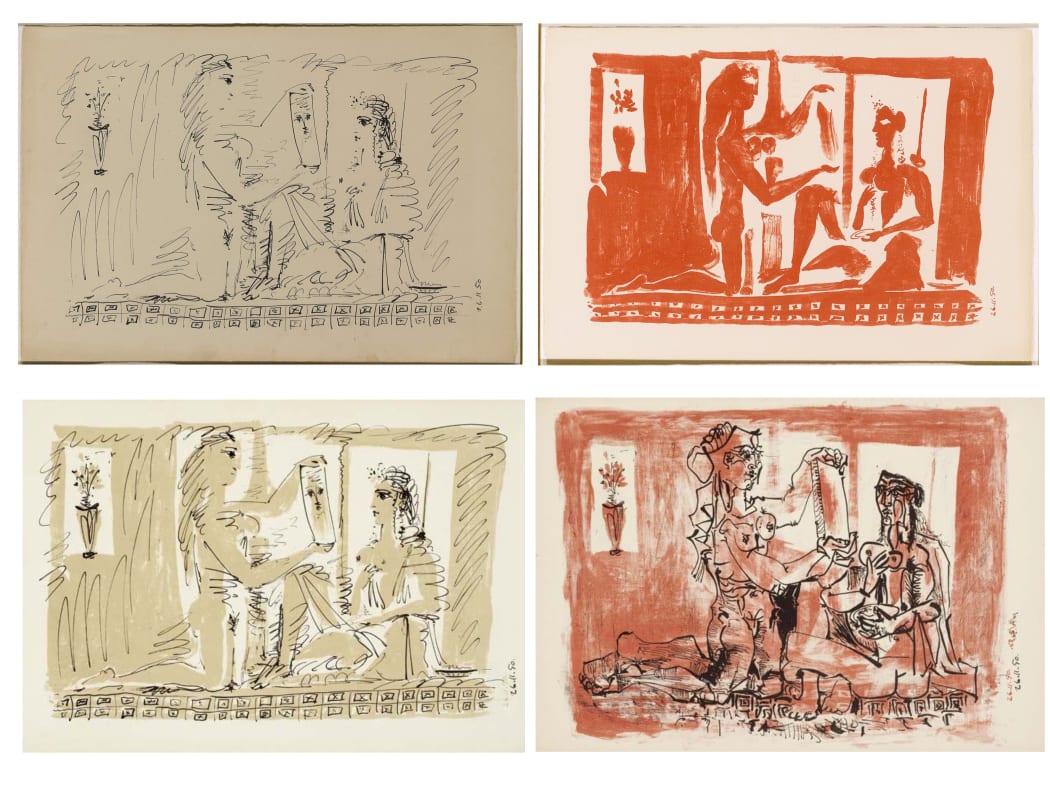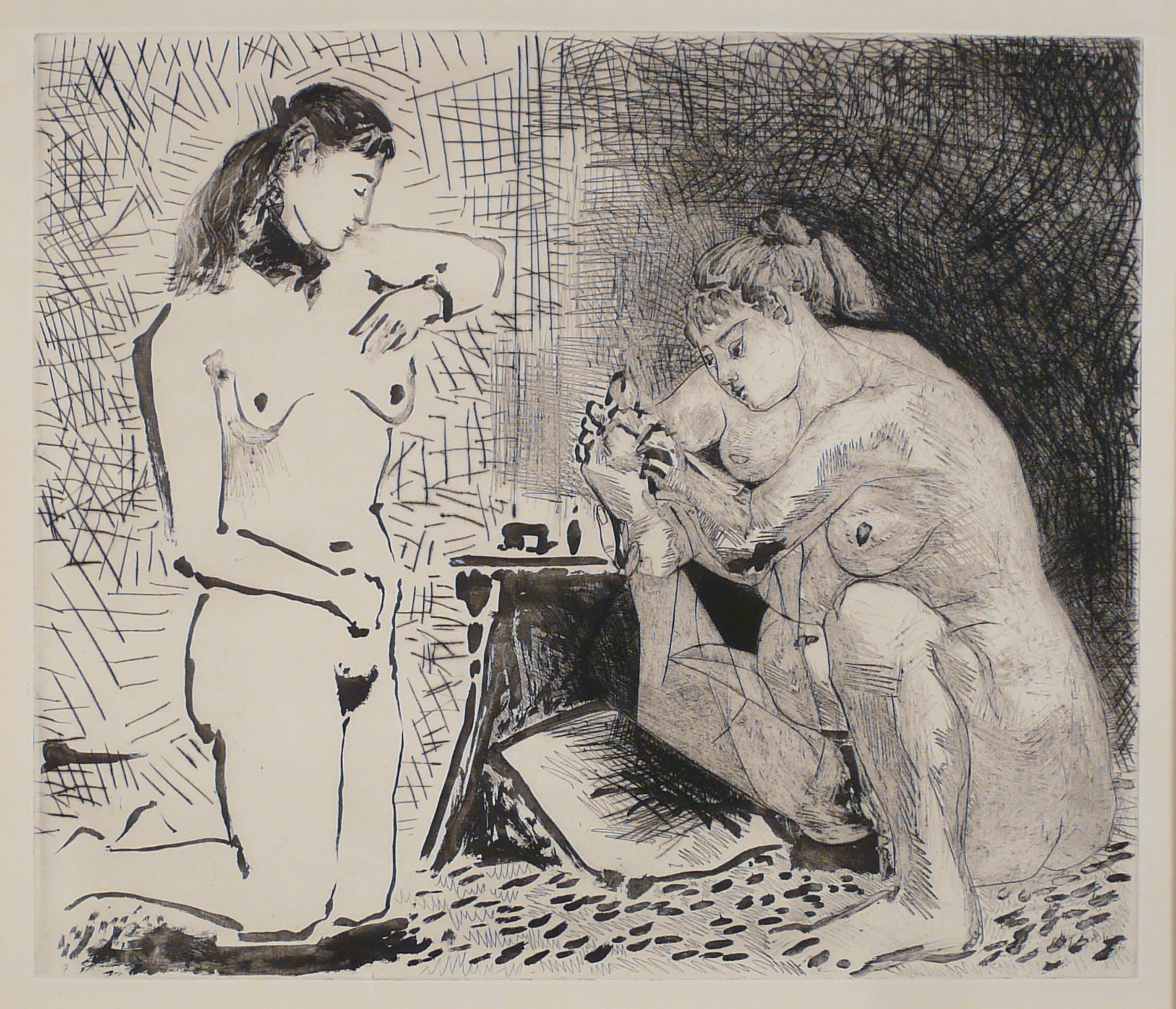
For the past two weeks, we’ve met Picasso at the end of World War II, hand in hand with a new love and a (relatively) new technique interest: respectively, Francoise Gilot, and the lithograph. Let’s take a brief break from romance and a deeper look at style. What was it that drew Picasso – an artist with a comfortable relationship to etchings, who worked with them as though they were living entries to a diary – to the lithograph? Said another way, what is the impact, on the viewer, of an etching, versus a lithograph?
Picasso lends us the perfect case study for these questions: a series of six progressive lithographic proofs created between 1950 and 1953 and an etching done in 1955. The subjects of these prints are, if not reimaginations of the same scene, closely related. As the title of the lithographs lightly suggests (La femme au mirror), and the etching’s title essentially reveals (Maison close: la toilette II), the women depicted are workers of the oldest profession, preparing and coifing, presumably before a day’s work.
Let’s begin with Picasso’s first take on the subject, the lithographs. In these, the figures seem to morph through all his different stylistic periods: we see a neoclassical state, a Cubist-like state, a state resembling the style of the Suite Vollard. In all, one woman holds up a mirror and the other sees herself in it. The scene could be mistaken for some fairy tale, in which the princess brushes her hair one hundred times and whispers her secrets to her handmaiden. But the women’s nudity and the decadence of their surroundings makes clear that they are not in some royal chamber, rather they are seated on the cushioned floor of a brothel. The image is flat, two-dimensional like a hieroglyphic drawing. In this, the lithograph’s style calls back to a more ancient practice of art. The effect of the technique is an impression on the viewer – that this scene is something as traditional as a fairy tale; or, that it’s something sacred, a piece of human history. The fact that this artwork is not actually ancient points out the very un-ancientness of the brothel scene, its very right-nowness (or, for Picasso, right-thenness). The special quality of the lithograph is within its ability to simplify – and in this, draw out – complexity.

Maison Close: La Toilette II (Ba925), 1955, Aquatint, etching, drypoint and engraving, 17 5/8 x 20 3/4 inches
La femme au mirror (M197) was never editioned, and neither was Picasso’s revisitation to the subject, Maison close: la toilette II (Ba0925) – perhaps this one was given the snub from Francoise, for in this second take, the impact on the viewer has no better word than personal. In an etching, there is enhanced depth; its texturization evokes a sensory experience – seeing shadow, feeling the smoothness of skin versus the velvet of a pillow. The etching renders the scene as tactile, bodily, emotional. The subject feels close to the viewer – these women are people, they are not part of some fairy tale. And as the woman who glances down at her watch, keen to be punctual for her next appointment, and the other woman, who scratches at a momentary itch on her foot, seem to be telling us, this scene is happening now; it is not some long ago fragment of the past. Therein lies the etching’s special power: to take a scene outside of our experience and make it urgent, make it as vividly three-dimensional as a memory. Interestingly, etching, which makes an image feel so immediate, is a much older printmaking technique than lithograph.
Surely there is infinitely more to be said about the distinct charms of these two styles, and the way their technical features create specific sensory impressions on we susceptible viewers of art. But to close this week, we feel compelled to share a word on Picasso’s choice of subject. Though the legendary status of his Demoiselles d'Avignon may beg to differ, Picasso far from invented this motif – it’s as old as the business itself. Which is to say, as old as human history. To get a little more specific in time, art historian Hollis Clayson points out that from the 19th Century, the prostitute’s depiction embodied – challenged – a social fear, a discomfort with the most bodily, most ancient, most undeniable of human facts.* For the writer Charles Baudelaire, the motif might even be the quintessential one of le peintre de la vie Moderne. In his eponymous essay of 1863, Baudelaire makes his protagonist “the man of the crowd,” one whose eye alone could pick up a “‘particular beauty, the beauty of circumstances and the sketch of manners.’”** It is no wonder then that art historians love to lend Picasso that prestigious title, the painter – that is, the printmaker – of modern life.
*Clayson, Hollis. Painted Love: Prostitution in French Art of the Impressionist Era, Getty Research Institute (1991).
**Willette, Jeanne. “Baudelaire and ‘The Painter of Modern Life.’” (2010).
Comments
Hello,
I just want to comment how wonderful these email lessons are. so full of information and relative to Picasso life and techniques and passion.
Thank you so so very much!
~Timothy
